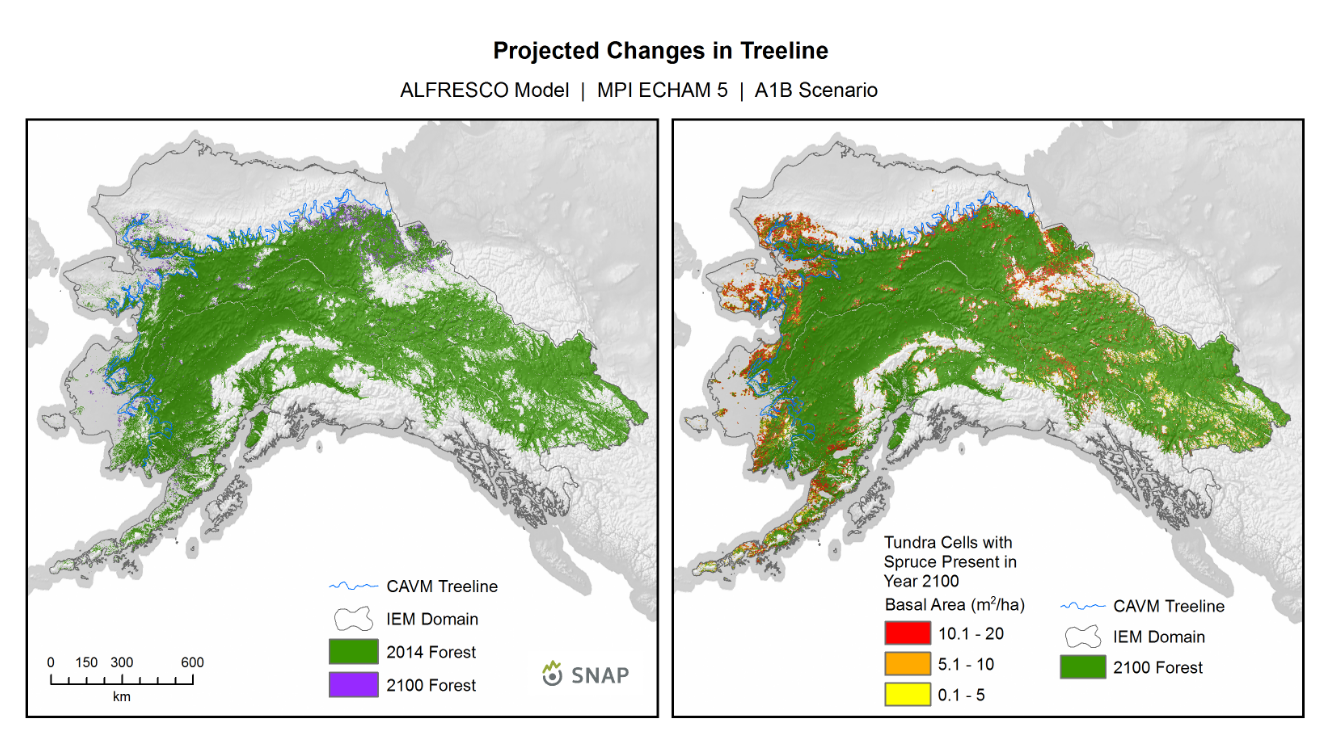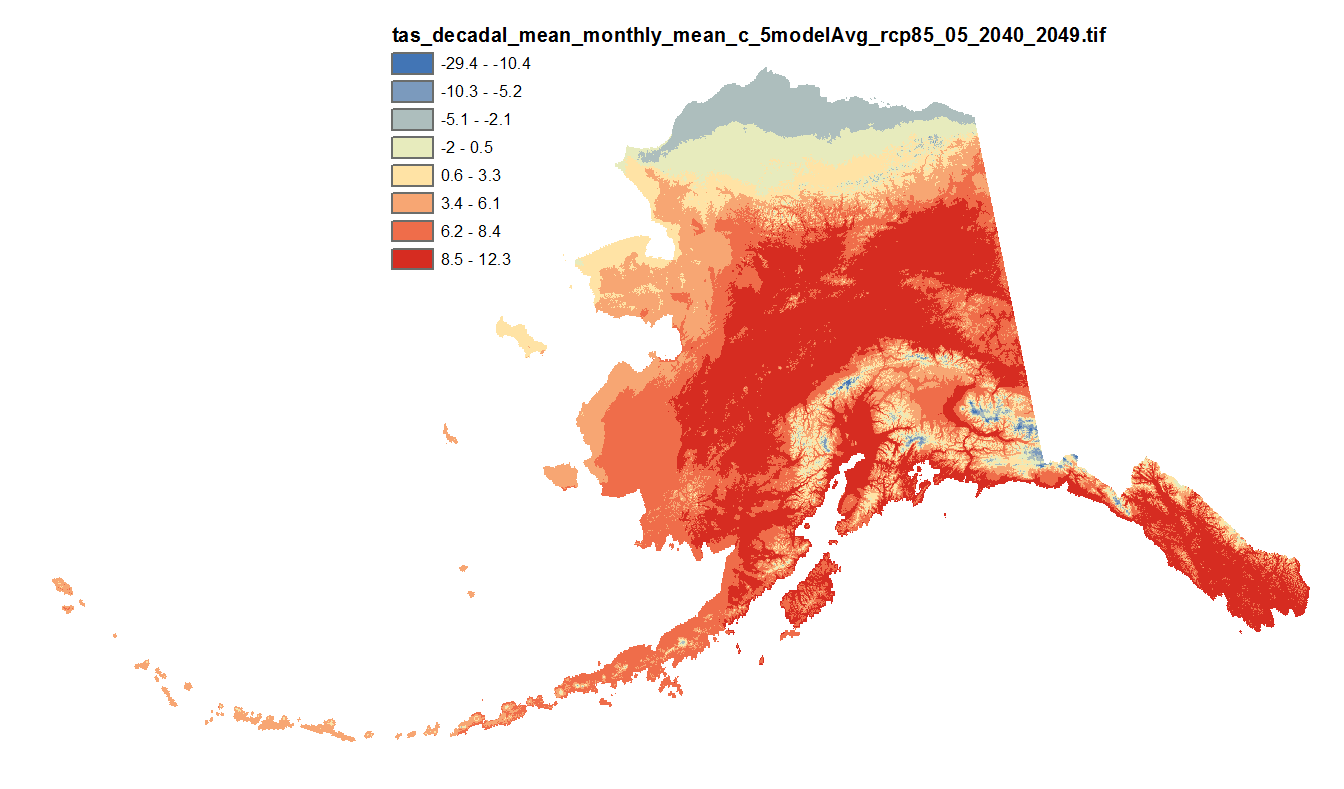2015
Type of resources
Topics
Keywords
Contact for the resource
Provided by
Years
Formats
Representation types
Update frequencies
status
Resolution
-

These are map products depicting modeled treeline dynamics. The left panel indicates modeled treeline dynamics from a single 2014 baseline year to the year 2100. The right panel indicates basal area accumulation on a 1km x 1km pixel basis during the year 2100, which gives an indication where possible further treeline advance may occur beyond 2100. The source datasets used to create these maps can be found here: https://catalog.snap.uaf.edu/geonetwork/srv/eng/catalog.search#/metadata/53b35453-7b88-4ea7-8321-5447f8926c48 ALFRESCO is a landscape scale fire and vegetation dynamics model. These specific outputs are from the Integrated Ecosystem Model (IEM) project, and are from the linear coupled version using AR4/CMIP3 and AR5/CMIP5 climate inputs (IEM Generation 1a). These outputs include data from model rep 171(AR4/CMIP3) and rep 26(AR5/CMIP5), referred to as the “best rep” out of 200 replicates. The best rep was chosen through comparing ALFRESCO’s historical fire outputs to observed historical fire patterns. Single rep analysis is not recommended as a best practice, but can be used to visualize possible changes. The IEM Generation 1 is driven by outputs from 4 climate models, and two emission scenarios: AR4/CMIP3 SRES A1B CCCMA-CGCMS-3.1 MPI-ECHAM5 AR5/CMIP5 RCP 8.5 MRI-CGCM3 NCAR-CCSM4
-

This set of files includes downscaled projections of monthly means, and derived annual, seasonal, and decadal means of monthly mean temperatures (in degrees Celsius, no unit conversion necessary) from Jan 2006 - Dec 2100 at 771x771 meter spatial resolution. For seasonal means, the four seasons are referred to by the first letter of 3 months making up that season: * `JJA`: summer (June, July, August) * `SON`: fall (September, October, November) * `DJF`: winter (December, January, February) * `MAM`: spring (March, April, May) The downscaling process utilizes PRISM climatological datasets from 1971-2000. Each set of files originates from one of five top-ranked global circulation models from the CMIP5/AR5 models and RCPs or is calculated as a 5 Model Average.
-

This 1km land cover dataset represent highly modified output originating from the Alaska portion of the North American Land Change Monitoring System (NALCMS) 2005 dataset as well as the National Land Cover Dataset 2001. This model input dataset was developed solely for use in the ALFRESCO, TEM, GIPL and the combined Integrated Ecosystem Model landscape scale modeling studies and is not representative of any ground based observations. Use of this dataset in studies needing generalized land cover information are advised to utilize newer versions of original input datasets (2005 NALCMS 2.0, NLCD), as methods of classification have improved, including the correction of NALCMS classification errors. Original landcover data, including legends: NALCMS http://www.cec.org/north-american-land-change-monitoring-system/ NLCD 2001 https://www.mrlc.gov/data?f%5B0%5D=region%3Aalaska Final Legend: value | class name 0 | Not Modeled 1 | Black Spruce Forest 2 | White Spruce Forest 3 | Deciduous Forest 4 | Shrub Tundra 5 | Graminoid Tundra 6 | Wetland Tundra 7 | Barren lichen-moss 8 | Heath 9 | Maritime Upland Forest 10 | Maritime Forested Wetland 11 | Maritime Fen 12 | Maritime Alder Shrubland** Methods of production: Due to specific models' land cover input requirements, including the fact that each model is primarily focused on different descriptive aspects of land cover (i.e. ALFRESCO considers land cover in respect to how it burns, TEM considers land cover in respect to how it cycles carbon through the system, and GIPL considers land cover with respect to its influence on the insulative qualities of the soil).
-

These annual fire history grids (0=no fire, 1=fire) were produced directly from the BLM Alaska Fire Service database and the Canadian National Fire Database. They are simply a 1x1km raster representation of their fire history polygon database that can be obtained from: http://fire.ak.blm.gov/predsvcs/maps.php http://cwfis.cfs.nrcan.gc.ca/datamart Note, fire history data is very unreliable before ~1950 in Alaska. Fires may have been recorded in a given year, but that does not mean all fires that occurred were successfully recorded. This data was assembled from every recorded fire that has been entered into Alaska and Canadian databases. This results in several years containing no fires at all.
-

This set of files includes downscaled historical estimates of monthly temperature (in degrees Celsius, no unit conversion necessary) from 1901 - 2013 (CRU TS 3.22) at 10 min x 10 min spatial resolution. The downscaling process utilizes CRU CL v. 2.1 climatological datasets from 1961-1990.
 SNAP GeoNetwork
SNAP GeoNetwork